
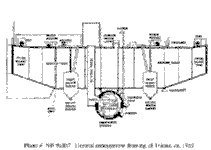
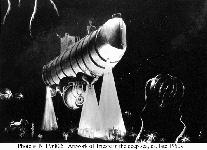
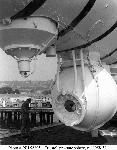
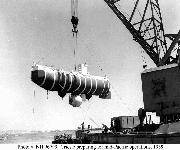
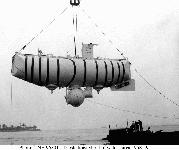

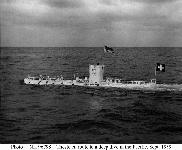
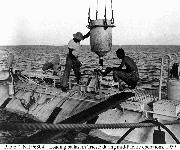
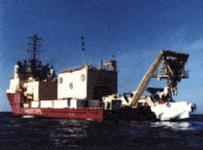
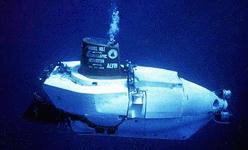
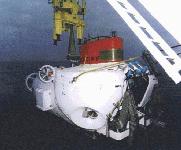

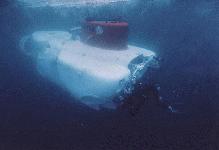




The bathyscaphe ("bathy" = deep, "scaphe" = ship) Trieste was built in 1953 at Naples, Italy, by the Swiss scientist Auguste Piccard. The Trieste, essentially a steel sphere attached to large float filled with aviation petrol for buoyancy, lacked manipulators or samplers, and it was quite large and not very maneuverable. But it allowed unprecedented observations from the water surface down to the benthos (organisms that live on or in the ocean bottom) and provided a tantalizing glimpse of future discoveries. After several years of operations in the Mediterranean, she was purchased by the US Navy in 1958, under the sponsorship of Office of Naval Research. Transported to San Diego CA she conducted tests in the Pacific during the next several years. In October 1959, after being fitted with a stronger pressure sphere, Trieste was transported to the mid-Pacific to participate in Project "Nekton", in which she conducted a series of very deep dives in the Marianas Trench. On 27 January 1960 the Trieste took two men to a depth of 35,800 ft ft (10,910 meters) -- the deepest spot in the ocean -- in the Mariana Trench near Guam. It took 5 hours to fall 7 miles, and when the explorers reached the bottom they stayed 20 minutes. No one has been able to come near that depth since then. At this depth, the pressure is over 8 tons per square inch. In 1963, she went to the Atlantic to search for the lost submarine USS Thresher (SSN-593). In August 1963, Trieste found Thresher's remains off New England, 1400 fathoms below the surface. The bathyscaphe was retired soon after that, and some of her components were used in the newly constructed Trieste II. Trieste is currently on display at the Washington Navy Yard museum.
When the submarine Thresher was lost, a committee established under Admiral Stephan [the oceanographer of the Navy] to assess the implications of the accident concluded that the Navy did not have the operational assets to conduct missions in the deep sea. To rectify this deficiency the Deep Submergence Systems Project, initially assigned to the Special Projects Office responsibile for developing the Polaris Fleet Ballistic Missile System, was established to develop deep ocean capabilities. Subsequently other associated development programs were assigned to the Deep Submergence Systems Project office, including the development of the NR-1 nuclear powered research submarine. The intelligence community also established Deep Submergence development requirements.A decision was made to build a second bathyscaphe, Trieste II, with the original Trieste assigned to the Deep Submergence Systems Project to test equipment that would be employed on other deep submergence systems. The new Trieste II, built at the Mare Island Naval Shipyard in September 1965, was a more sophisticated craft capable of clandestine operations in the deep ocean. When the Scorpion was lost, the previously unacknowledged Trieste II was used by the Navy to carry out the investigation. In June 1971 Trieste II was designated Deep Submergence Vehicle [DSV-1], and in May 1984 she was assigned to Submarine Development Group 1. She was moved to the Keyport Naval Undersea Warfare Center in 1985.
The subsequent development of occupied research submersibles focused on systems allowing access to undersea depths of up to 6,000 meters (20,000 ft). The ambient pressure at these depths is over 4 tons per square inch, of order the same pressure that structural engineers must deal with in designing mechanical support systems for skyscrapers. Although the design of a simple structural items may be straightforward in principle, in practice they may fail due to changes in tolerance or material deformation due to such ambient pressures. Most submersibles have much shallower diving capabilities (300 meters to 3,000 meters). Of the vehicles in the Navy inventory (or operated by academic contractors for the Navy), the nuclear-powered NR-1 is rated at only 3,000 feet, and the DSRVs (Deep Submergence Rescue Vehicles) Mystic (DSRV-1) and Avalon (DSRV-2) are rated to only 5,000 feet.
In 1962 the Office of Naval Research (ONR) and Woods Hole Oceanographic Institution (WHOI) began work on a more maneuverable submersible capable of operating at depths greater than 6,000 feet. Three 6-foot diameter HY-100 steel spheres were fabricated, and on 05 June 1964 the DSV-2 Alvin was commissioned. The sub proved its worth in 1966 by assisting in the search for and recovery of a US hydrogen bomb accidently lost in 780 meters of water off the coast of Spain. The three-place submersible Alvin", operated by Woods Hole Oceanographic Institution (in Massachussetts) for the Office of Naval Research, has four viewing ports, video and still cameras, one six function and one seven function manipulator, scanning sonar, and can be fitted with a variety of other specialized equipment. Since 1971 Alvin has been "loaned" by the Navy to Woods Hole. During a 1972-1973 overhaul, a new titanium personnel sphere was installed in Alvin to double the sub's depth capability to 3,658 meters (12,000 feet). Maximum operating depth was 4,000 m (13,100 fsw), but after a prolonged effort, in 1994 the US Navy approved an increase of Alvin's operating depth from 4 000 meters to 4500 meters. This depth increase results in about 25% more of the ocean floor within reach of Alvin, about 86% of the ocean basins. By 1994, the 30th year of operation, none of the original Alvin remained in use, since every component of the original vehicle had been replaced over the years, including the frame and pressure hull. The other two spheres originally fabricated for the Alvin were later used for the Navy's Turtle (DSV-3) and her sister ship Sea Cliff (DSV-4), built to a design similar to the Alvin. Turtle has video and still cameras, two six-function hydraulic manipulators, and four large view ports. Sea Cliff has two 7-function hydraulically operated manipulator arms, three 11-cm view ports, and video and still camera systems. While the Turtle is rated at 10,000 foot operating depth, Sea Cliff had her original HY-100 steel crew sphere replaced in 1983 with a titanium sphere capable of 20,000 foot operations. Sea Cliff reached this depth for the first time in March 1985, during a dive in the Middle America Trench off the Pacific coast of Central America. This increase of 1500 meters over Alvin's limits provides access to 37% more of the sea floor.All three of these DSVs are constructed of a fiberglass hull over the metal crew sphere, batteries and electric motors. The craft have television and still cameras, external lights, short-range sonars, and hydraulic remote-control manipulators. Alvin weighs 16 tons, Turtle weighs 21 tons, Sea Cliff weighs 29 tons. These DSVs have an endurance of 8 hours at 1 knot, or 1 hour at 2.5 knots. Due to their limited range and endurance, their mother ship should be certain to remain in the vicinity.
Alvin's normal support ship is Woods Hole's Atlantis II, although she has on occasion been transported by appropriately equipped Navy Landing Ship Dock (LSD) vessels. Turtle and Sea Cliff have also been based from LSDs, or, more commonly, from Navy oceanographic vessels. Any of the three can be transported by C-5 aircraft, although such deployments are now uncommon.
Many submersibles control in-water trim by shifting mercury between chambers at either end of the vehicle. Mercury is also corrosive to aluminum, extremely toxic, requires extraordinary measures to prevent spills, and is difficult to clean up when a spill occurs. The Battelle "tungsten ball trim system" is the replacement trim system for Sea Cliff and Turtle. In this system sintered tungsten balls are the weight medium, stored in two stainless steel tubing coils at either end of the vehicle which are connected by a transfer line. Hydraulic fluid moves the balls through the tubing by means of slip flow past each ball, and plastic balls on either end of the daisy chain of tungsten balls provide a filler in the transfer tube when all the weight is shifted one way or the other.
Since the end of the Cold War the submersibles Sea Cliff and Turtle and ROV ATV have been available for limited academic research through a cooperative arrangement between NOAA and the US Navy's Submarine Development Squadron Five in San Diego CA. These vehicles have expanded opportunities for peer-reviewed deep submergence research off the US west coast. Sea Cliff and ATV have provided the science community with some additional access to the deep sea and permitted observations to depths approaching 6000 meters, a depth range otherwise only available by using ROV Jason or the other tethered vehicles of the National Deep Submergence Facility. This increase of 1500 meters over Alvin's limits provides access to 37% more of the sea floor, which represents an area that is greater than 90% of the surface area presently exposed on the continents.Following the Navy's decision to decommission Sea Cliff, NAVSEA requested Woods Hole Oceanographic Institution (WHOI) to provide a technical assessment and costing of how to best integrate Sea Cliff into the National Deep Submergence Facility. Perhaps the most serious and biggest impediment to integrating Sea Cliff into the US deep submergence program is the lack of an adequate and stable funding base.
With the advent of remotely operated and autonomous vehicles over the last decade, the crewed submersible's utility has declined, and Turtle and Sea Cliff have been retired. According to the Naval Vessel Register, the somewhat puzzling "DSV-5" remains in service, but the fact of the existence of this vehicle is not widely attested and details remain entirely obscure.Specifications | |
| Power Plant | Five hydraulic thrusters: 3 forward-aft, 2 lift, 1 rudder Lead-acid batteries, 36 KWH usable, 12/26 VDC, 110 VAC |
| Length | 23 feet - DSV-2 26 feet - DSV-3 & 4 |
| Beam | 8 feet, 6 inches |
| Draft | 7 feet, 6 inches |
| Displacement | 30 tons - DSV-4 |
| Speed | 1 - 2.5 knots |
| Depth |
4,500 meters (14,500 fsw) - DSV-2 3,050 meters (10,000 fsw) - DSV-3 6,100 meters (20,000 fsw) - DSV-4 |
| Range | 6 miles |
| Dive Duration | 6-10 hours |
| Crew | 3 |
Ships | ||||||
| Name | Number | Builder | Homeport | Ordered | Commissioned | Decommissioned |
| Trieste I | 1953 | |||||
| Trieste II | DSV-1 | Mare Island | Keyport | 01 Jun 1964 | ?~ 1985 | |
| Alvin | DSV-2 | General Mills | Woods Hole | 05 Jun 1964 | 01 Jun 1971 | |
| Turtle | DSV-3 | Electric Boat | San Diego | 01 Jun 1970 | 01 Oct 1997 | |
| Sea Cliff | DSV-4 | Electric Boat | 01 Jun 1970 | 01 Aug 1998 | ||
| DSV-5 | 01 Jun 1970 | |||||













